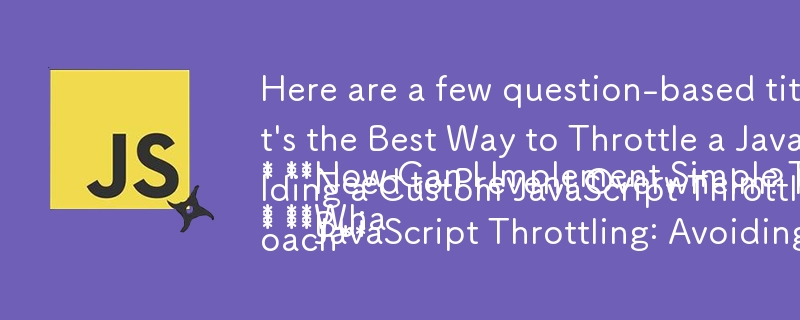Home > Article > Web Front-end > Here are a few question-based titles that fit the content of your article: * **How Can I Implement Simple Throttling in JavaScript?** * **What\'s the Best Way to Throttle a JavaScript Function?** *
Here are a few question-based titles that fit the content of your article: * **How Can I Implement Simple Throttling in JavaScript?** * **What\'s the Best Way to Throttle a JavaScript Function?** *
- Mary-Kate OlsenOriginal
- 2024-10-25 08:54:28855browse

Simple Throttling in JavaScript
In JavaScript, throttling is a technique to limit the execution of a function to a specific time interval. This is useful when you want to avoid overwhelming the system with excessive function calls.
Existing Throttle Implementations
Libraries like lodash and underscore provide built-in throttling functions. However, including these entire libraries for a simple task can be redundant.
A Custom Throttle Function
Here's a custom throttle function that can be used as a standalone solution:
<code class="javascript">function throttle(fn, threshhold, scope) {
threshhold || (threshhold = 250);
var last,
deferTimer;
return function () {
var context = scope || this;
var now = +new Date,
args = arguments;
if (last && now < last + threshhold) {
// hold on to it
clearTimeout(deferTimer);
deferTimer = setTimeout(function () {
last = now;
fn.apply(context, args);
}, threshhold);
} else {
last = now;
fn.apply(context, args);
}
};
}Improvement: Avoiding Duplicate Execution
The provided code, however, exhibits an issue where it may fire the function again once the throttle interval has elapsed. To address this, we can modify the function as follows:
<code class="javascript">function throttle(fn, threshhold, scope) {
threshhold || (threshhold = 250);
var last,
deferTimer;
return function () {
var context = scope || this;
var now = +new Date;
if (now < last + threshhold) {
return; // prevent subsequent execution
}
last = now;
fn.apply(context, arguments);
};
}Advanced Throttle Function
For more flexibility and additional options, you can refer to the following implementation:
<code class="javascript">function throttle(func, wait, options) {
var context, args, result;
var timeout = null;
var previous = 0;
if (!options) options = {};
var later = function() {
previous = options.leading === false ? 0 : Date.now();
timeout = null;
result = func.apply(context, args);
if (!timeout) context = args = null;
};
return function() {
var now = Date.now();
if (!previous && options.leading === false) previous = now;
var remaining = wait - (now - previous);
context = this;
args = arguments;
if (remaining <= 0 || remaining > wait) {
if (timeout) {
clearTimeout(timeout);
timeout = null;
}
previous = now;
result = func.apply(context, args);
if (!timeout) context = args = null;
} else if (!timeout && options.trailing !== false) {
timeout = setTimeout(later, remaining);
}
return result;
};
};</code>The above is the detailed content of Here are a few question-based titles that fit the content of your article: * **How Can I Implement Simple Throttling in JavaScript?** * **What\'s the Best Way to Throttle a JavaScript Function?** *. For more information, please follow other related articles on the PHP Chinese website!
Related articles
See more- An in-depth analysis of the Bootstrap list group component
- Detailed explanation of JavaScript function currying
- Complete example of JS password generation and strength detection (with demo source code download)
- Angularjs integrates WeChat UI (weui)
- How to quickly switch between Traditional Chinese and Simplified Chinese with JavaScript and the trick for websites to support switching between Simplified and Traditional Chinese_javascript skills